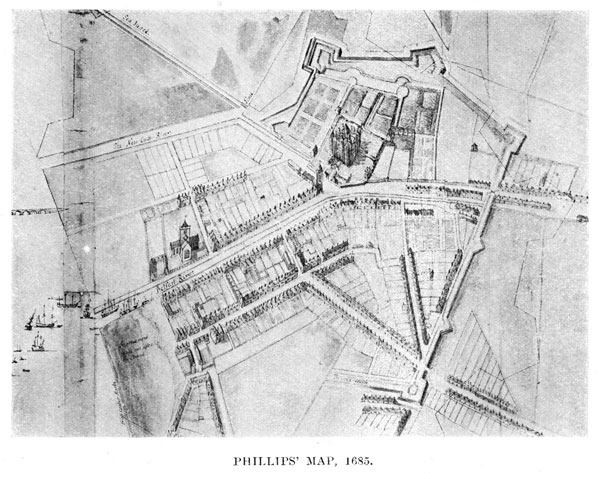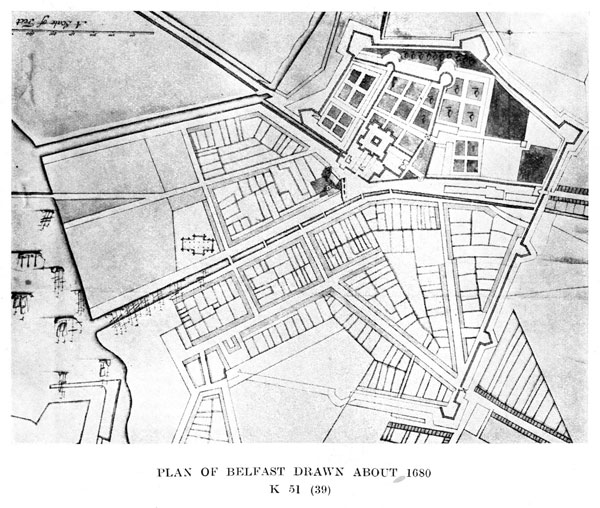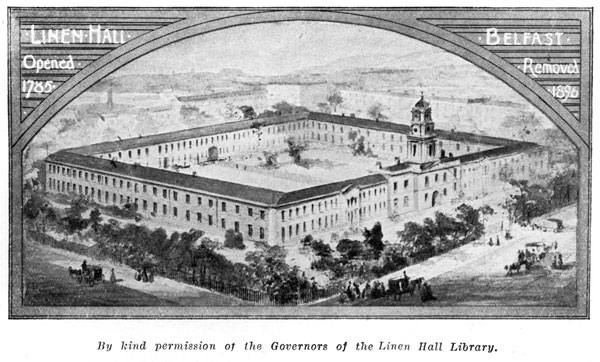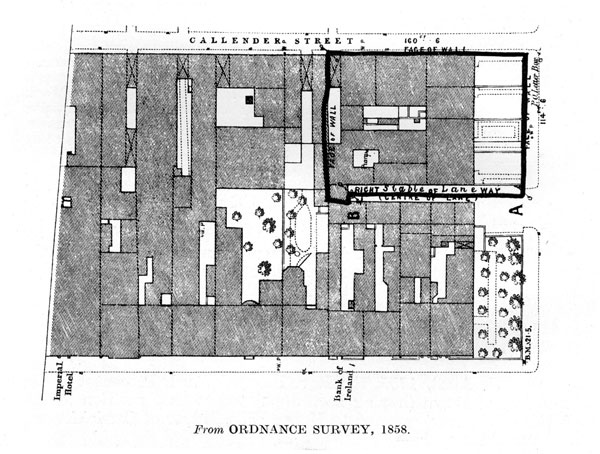DONEGALL PLACE.
It is an old but somewhat hackneyed statement that Rome was not built in a day. Three quarters of a century had elapsed before the scheme for developing the Castle Gardens was made known to the public. In 1783, seventy-five years after the Castle Fire, Arthur, 5th Earl of Donegall, had the ground surveyed for opening a roadway through Robin's Orchard from the western end of The Parade and running due south. That survey appears on the Counterpart Lease of the White Linen Hall, afterwards the site of the City Hall. Through the kindness of Mr. John Bristow, Solicitor, the plan of the survey is reproduced on the opposite page.
A graphic description of the locality can be seen from the parcels of a lease granted by Arthur, 5th Earl of Donegall to George Black, Esq.; William Legg of Malone; John Russell of Edenderry, Co. Down; and Francis Turnly of Newtownards, Co. Down, bearing date 4th September, 1784 :--
"all that piece or parcel of meadow ground being part of the Castle Meads situate on the S side of the Castle and Town of Belfast... and near the ancient Ramparts of the Castle and containing in front towards the N next the said Ramparts and likewise at the S side or rere thereof 382 feet each... and at the E and W end thereof 282 feet... which said piece or parcel of ground is more particularly described as to its buttals and mearings in the plan hereunto annexed and all erections and buildings thereon... with a free way and passage for passengers, horses, carts, and carriages to pass and repass at all times hereafter to and from the ground and premises herein mentioned to and from the said town of Belfast and in, by, and through the Stable Yard and Gardens therein belonging to the said Castle of the width of 80 feet throughout and in a direct line from the centre of the front of the then intended Hall to High Street nearest Street as also a like freeway and passage at all times hereafter along the front and rere and on each side of the ground herein mentioned of the full width of 50 feet in every part for the better accommodation and enjoyment of the said intended Hall or Market House."
"To Hold... upon the trusts herein mentioned subject to the yearly rent of £4 10s. 0d. upon trust to permit and suffer a Hall or Market House to be erected and stand and be continued thereon for the Publick Sale of White Linens and to be used as such at all times in such manner and under such rules, orders, and regulations as the Subscribers thereto... or major part of those in value or in any Committee or Committees to be appointed by them for that purpose should from time to time direct, limit, and appoint."


The Maps on the two preceding pages are drawn from a different point of view. The earlier one, K.51 (39), is drawn in the usual way, with a northern aspect, whereas Phillips looks towards the south, probably for the purpose of giving a perspective view of the Castle. In order that the two maps may be looked at from the same point of view, K.51(39) has been reversed, so that by looking at the two maps from the outside right-hand edge of the book, a comparison is more easily obtained. At the lower right-hand corner of K.51 (39), there may be seen an indication of a gate in the Ramparts, colloquially known as the North Gate, being at the north end of North Street, which, by the way, runs more towards the west than the north. No such indication of a gate is shown by Phillips at this point, but he shows a somewhat elaborate gate at the Strand, which is not shown on Map K.51 (39).
The foundation stone of the White Linen Hall was laid by John Brown, the Worshipful Master of a Masonic Lodge, called Orange Lodge 257 on 28th April, 1783, and the building was opened for the sale of white linen on 13th September, 1784, nine days after the lease of the premises had been duly executed.

Referring now to the Plan we see that "the intended street to the Linen Hall ran due north and south with the front of the Linen Hall at right angles, consequently due east and west; that the site of the Hall was south or outside of "the ancient ramparts of the Castle," being in the "old Cherry Garden"; and that the south-west corner of the Linen Hall occupied portion of The Mall or walk from Joy's Paper Mill to the present Fountain Street.
The intended New Street was called Linen Hall Street and leases of building sites were granted thereon. As these leases were printed in a stereotyped form with spaces to be filled in for each particular grant, the printed covenants contained in one lease will give an idea of Donegall Place in its infantile stage.
"... within two years... erect and build... on the whole front of the said ground hereby demised next Linen Hall Street good and substantial messuages or tenements of Brick and Lime or Stone and Lime and shall cause the front of the said Messuage to be fashed and the Roofs thereof to be well slated and to range with the highest houses in the same street uniformly throughout and all the Side Walls ... to be built 27 feet high above the surface of the ground and 14 inches thick at least and that all Girders, Joists, and Roofing and other Timbers that shall be used or put therein shall be of good Oak or Fir and of proper Scantlings respectively."
"Shall cause 6 feet of the ground lying next the front to be paved with Flag Pavement and all the Rest of the ground in front of the said Messuage to the middle of the street before the same to be well paved with Stones or pebbles."
The name Donegall Place was substituted for Linen Hall Street and the latter name was transferred to the street running due south from the back of the Linen Hall. Consequently the name Linen Hall Street has been applied to three different thoroughfares, viz., Donegall Street, Donegall Place, and the present Linen Hall Street.
The Rev. Narcissus Batt, A.M., in the Ulster Journal of Archaeology, 1895, says in "Recollections of a Septuagenarian" :--
"Donegall Place was a quiet street of private houses. Some of them had gardens and trees in the rere, but there was quite a grove at the corner of the Square where Robinson and Cleaver now have their establishment... There were four members of our family domiciled in Donegall Place. My father, Samuel Hyde Batt, lived at No.6... where I was born. Thomas lived at No.4... The Rev. William Batt lived near Fountain Street. The Nelson Club was next door to us... Thomas L. Stewart resided at "The Castle", at the corner of Castle Place, a plain mansion with a walled garden at the front... Our premises behind reached to Calendar Street... Narcissus Batt lived at the Royal Hotel till Purdysburn was finished."
The Royal Hotel in which Narcissus Batt resided for a short time still remains in situ, and is indicated by the building with the Royal Arms on the roof. The house is often spoken of as the Marquis of Donegall's town house, but he only resided in it for a short time as a tenant, having been previously occupied by General Nugent, during the 1798 Rebellion.
The original lease, bearing date 29th April, 1786, was from Arthur, 5th Earl of Donegall to John Brown, merchant, for 99 years at £20 5s. 0d. yearly, the parcels of which are :--
"all that piece or parcel of ground situate on the W side of Linen Hall Street, containing in width at the front next the said street 60 feet and extending backwards to the W to a lane between the same and The Mall 250 feet on the S side thereof."
It should be mentioned that the lessee was not John Brown of Peter's Hill who was Sovereign, but one of the "Four Johns who founded the Belfast Bank in 1787 and is consequently described in the lease as "merchant". He is, however, described as "Banker" in a later deed, bearing date 1st January, 1800, in which John Campbell, James Joy, Thomas Brown, merchants, Trustees named in the Will of John Brown, banker, deceased, conveys, in consideration of £91, to John Brown of Carnaghlex in the County of Antrim, farmer --
"all that piece or parcel of ground at the rere of three tenements then in the possession of Dr. James McDonnell, James Luke, and John Smith in Linenhall Street whereon out offices and stables are partly built demised by Roger Mulholland to Hill Wallace Esq and producing a clear profit rent of £3 12 shillings and also that passage and open space of ground leading from Stable Lane to the tenements then in the possession of Narcissus Batt and set at a profit rent of 15 shillings yearly."
It was not, however, till 1806 that the leasehold interest of 29th April, 1786, passed out of possession of the Brown family.
By a deed, bearing date 10th ,Tune, 1806, John Browne and Brook Taylor Ottley of Dublin, merchants, Executors of John Brown, son of the elder John Brown, formerly of Merville in the County of Antrim and afterwards of Bellmount in the County of Dublin conveyed to R Hyndman, merchant:--
"all that piece or parcel of ground situate on the W side of Linen Hall Street, now called Donegall Place, in width at the front next the said street 60 feet and extending backwards on the W to a lane between the same and The Mall 250 feet on the S side thereof... To Hold for 99 years from 1st November, 1785, subject to £25 : 5 shillings yearly."
Benn was clearly under a misapprehension when he said (page 549), "in 1769, and many years later, the Castle Gardens and the Castle Meadows were still in all their luxuriance." The Pleasure Garden, as it existed in the 17th century, with its Pigeon House and Long-Walk, is described in a lease of 1716 as "meadow and pasture."
In the following year "Robin's Orchard" was leased for a term of 41 years to R Le Byrtt who, in 1718, granted a sub-lease of a portion to Samuel McClinto, vintner, with a proviso :--
"Bound to build a good Englishlike house within five years... of brick and lime with an oaken or firr roof and fixed loft and pave the street so made as fronts the said premises; and the said houses that shall be built upon the said premises, street paved, or fences made to be kept in sufficient repair at all times."
The Rev. Bernard Ward, Incumbent of Knockbreda Parish Church, was granted a lease, bearing date 30th August., 1754, for 41 years at an annual rent of £2 7 shillings, of :--
"all that piece... situate... in Castle Street in Belfast aforesaid, adjoining to the Castle Wall at the S W and containing in front 48 feet and the messuage or tenement thereon erected and the Offices at the N E end thereof between it and the street, now inhabited by Valentine Jones and the said Bernard Ward, with the old Stable opposite the said Offices; and also the Old Vault adjoining the said Dwelling-house on the S W Gavell (gable) : the Shade built against the S E side of the said Castle Wall; and a Spott of Ground about 18 feet long and 20 feet deep lying between the S E side of the said Shade and Valentine Jones's; Garden Wall; and the Garden in front of the said Dwelling-house; with one rood and 29 perches of ground to be taken off and separated from the Castle Garden, next to the Wall on the S W side of the road leading to the Long Bank."
The Rev. Bernard Ward subsequently surrendered his leasehold interest in the one rood 29 perches which by lease, bearing date 20th July, 1767, Arthur, 5th Earl of Donegall, granted to Thomas Greg for 28 years at two shillings yearly and therein described as "now in the possession of the said Thomas Greg and by him occupied as a Garden".
On 4th April, 1755, the Rev. Bernard Ward, Precentor of the Cathedral of Down (having been appointed to that position in the previous February) granted to Henry Ellis, Mayor of Carrickfergus, a 40 years' lease of :--
"all that dwelling-house now in the possession of the Widow Hemming, except the parlour, now a part of the house of the said Bernard Ward, together with the Stable opposite to the said dwelling-house."
From the recital of these various leases, it will be seen that the Castle Gardens, "in all their luxuriance" had terminated long prior to 1769, and that the old names, "The Castle" and "Castle Gardens" were retained after they had ceased to exist.
By lease, bearing date 1st October, 1802, Thomas Ludford Stewart was granted in perpetuity at the annual rent of £70 :--
"all that piece or parcel of ground situate, lying, and being on the E side of Linen Hall Street containing in width at the front next the said street 200 feet... and extending backwards in depth to the tenement of Cunningham Greg Esq 128 feet... and bounded on the S by Castle Lane; on the N by Castle Street, which said piece or parcel of ground is known and called by the name of the Castle Ground then in the actual possession of the said Thomas Ludford Stewart excepting and always reserving out of that demise... the Building or Office then used as the Castle Office for and receiving the rents of the said Marquis's Estates."

The above plan from the Ordnance Survey of 1858 shows Donegall Place from the Imperial Hotel to Robinson & Cleaver's. The house in which Samuel Hyde Batt resided, and in which the Rev. Narcissus Batt was born, is that with the large planted garden in the rere, portion of the old Castle Gardens, and is now occupied by S. D. Neill, Ltd. The house adjoining on the south is that in which Thomas Batt resided and is now Thompson's Restaurant.

